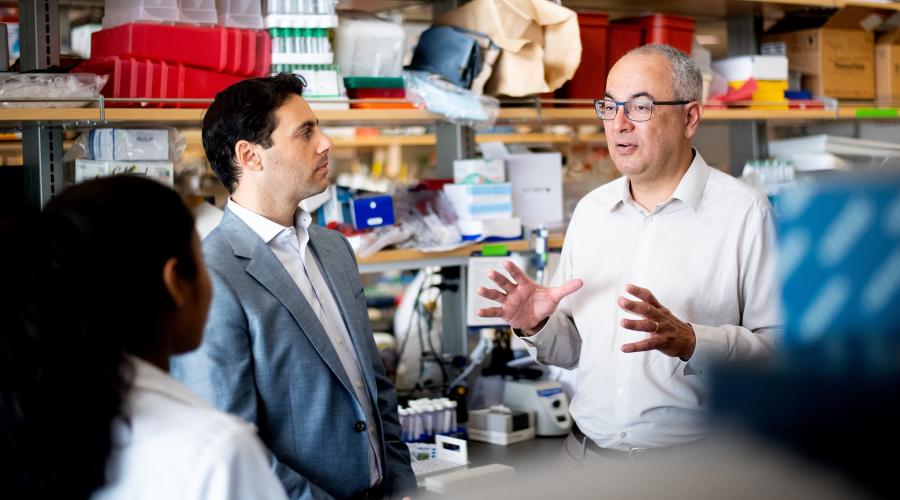
Unlocking New Frontiers: How UCSF Research is Changing the Future of Childhood Cancer
Every child is unique, and the future of cancer care depends on treating them that way — with precise, personalized therapies designed for their specific tumor. This requires a deep understanding of each tumor's unique biology and a powerful spirit of collaboration to turn those insights into improved therapies.
Few places in the world can match UCSF’s record of bringing discoveries from the lab to the clinic in pediatric cancer. Our Division of Pediatric Oncology is built on a collaborative, precision-focused model of translational research that brings the most advanced treatments to our patients. This bench-to-bedside approach is creating a new, more hopeful future for children with cancer, and the work of four of our investigators exemplifies our mission to give every child the best chance possible for a long and healthy future.

Personalizing a Cure for Leukemia
For decades, children with juvenile myelomonocytic leukemia (JMML), an aggressive childhood blood cancer, have faced a difficult path: a high-risk stem cell transplant that is toxic and only effective in about half of patients. Elliot Stieglitz, MD, is leading a shift away from this one-size-fits-all approach.
Stieglitz’s lab discovered that genomic and epigenetic "fingerprints" in a patient's tumor can accurately predict how severe their cancer will be. This foundational discovery has been directly translated into a new clinical trial that, for the first time, tailors therapy to a patient's specific risk profile.
The trial's personalized strategy offers a dual benefit: for the first time in JMML, low-risk patients may be able to avoid a transplant altogether, while high-risk patients will receive targeted drugs to achieve a deeper remission before their transplant to improve the likelihood of its success.
A Global Consortium for Brain Tumors

Developing drugs for rare pediatric brain tumors is incredibly challenging due to small, scattered patient populations. Sabine Mueller, MD, PhD, MAS, confronted this challenge by co-founding and leading the Pediatric Neuro-Oncology Consortium (PNOC), a global, agile, "biotech-style" clinical trial consortium.
PNOC has played a direct and pivotal role in the clinical trials that led to the FDA approval of two new drugs for pediatric brain tumors: tovorafenib for low-grade gliomas and dordaviprone (ONC201) for diffuse midline glioma, which causes over one thousand childhood deaths each year.
FDA approval provides new, life-saving options for children who previously had none and opens a new regulatory path to develop the next generation of combination therapies.

Leading the National Fight Against Neuroblastoma
Neuroblastoma, which starts in immature nerve cells, is one of the most lethal pediatric cancers and accounts for over 15% of all childhood cancer-related deaths. With nearly half of high-risk patients relapsing after initial treatment, there is an urgent need for new options.
UCSF has been a pioneer in this fight since the 1980s, when Katherine Matthay, MD, now retired, performed one of the earliest treatments in the U.S. using a targeted radiopharmaceutical known as MIBG therapy. As one of the only pediatric neuroblastoma programs in Northern California, UCSF remains a high-referral center for children with this disease.
Today, Kieuhoa Vo, MD, MAS, carries that legacy forward. While MIBG is a powerful tool, it is only effective in a fraction of relapsed patients when used alone. To improve its impact, Vo is leading national efforts through the New Approaches to Neuroblastoma Therapy (NANT) consortium, which Matthay founded in 2000. Her work on a new NANT trial that will combine MIBG with immunotherapy provides critical access to new anticancer therapies for children and young adults with relapsed or refractory neuroblastoma who desperately need new therapies.

Decoding Sarcomas to Find New Targets
Pediatric sarcomas, which are malignant tumors arising from bone and soft tissues, present a profound challenge due to their biological complexity and rapid spread to other parts of the body. Some, like osteosarcoma, are genomically chaotic, while others, like Ewing sarcoma, are driven by single, hard-to-target mutations.
Alejandro Sweet-Cordero, MD, is creating a large bank of patient-derived models to better understand how these diseases develop, resist chemotherapy, and metastasize.
His lab uses tumor fragments from patients to create living models of their cancer. Using sophisticated genomic analysis, his team deciphers the core biology of these tumors to uncover novel therapeutic vulnerabilities.
For diseases like osteosarcoma, where treatment has remained largely unchanged for decades, this foundational work represents a critical breakthrough. It serves as an engine of discovery, providing the biological insights needed to design the next generation of targeted clinical trials.
Together, the work of these four investigators showcases a cohesive and forward-thinking strategy in UCSF’s Division of Pediatric Oncology. Leadership isn’t just about treating today’s patients, but building a more hopeful future for every child diagnosed with cancer.
